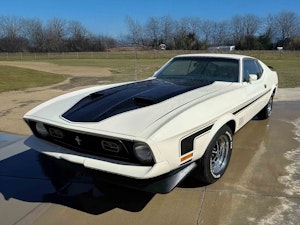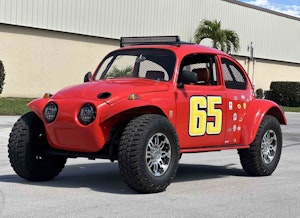Media | Articles
5 collectible pony cars that aren’t Mustangs
The Ford Mustang, besides being an incredible sales success, is also a cultural icon. The 1965 Mustang burst into the scene in April of 1964 just days after the Plymouth Barracuda. Even though the cars were competitors, and each aimed at the same market, the Mustang stole the show. There’s a reason that compact, sporty, highly customizable vehicles are called pony cars and not fish cars: Ford’s Mustang shaped the market.
However, though it’s the archetypal pony car, the Mustang is definitely not the only one worthy of praise. Here are five pony cars from Hagerty Marketplace that would make for a great project car or weekend driver—and, as it happens, none are Mustangs.
1969 Mercury Cougar
Mercury stepped into the pony-car market a couple of years after Ford paved the way with the Mustang. The more upscale Cougar eventually became a personal luxury car, with gradual moves toward that shift with each new generation, making the 1967–1970 models the closest in spirit to the Mustang and the rest of the pony-car class. As such, the first generation Cougar was nimble, sleek, and offered powerful V-8 options.
This car needs upholstery and bodywork to repair some front-end damage from a fender-bender, but besides the front seats, a lot of the interior still looks to be in good condition, and the body should be a solid candidate for restoration. Considering it shares a chassis with the first-gen Mustang, there’s no shortage of options when it comes to choosing parts for either a correct restoration or a restomod with a bit more handling prowess.
Marketplace
Buy and sell classics with confidence
1985 Chevrolet Camaro Z28
Third-generation Camaros seem to be resurging in popularity as kids that loved them when they were in high school are now old enough to add one to their collection. It’s a familiar pattern that led to the incredible boom of muscle cars in decades past.
This 1985 Z28 has just 76,000 miles on the odometer and a complete, seemingly immaculate interior that’s a rare find in a vehicle of this vintage. It’s powered by the second most powerful engine offered in 1985, a TBI 5.0-liter V-8. 1985 marked the first time that port injection was available, and both inductions were available. The TPI was known for generating incredible low-speed torque; off-the-line acceleration was fantastic, thanks to the system’s long runners while the TBI engines could easily pass for a carbureted model .
1979 Pontiac Firebird Trans Am
One of the few pony cars that could challenge Mustang for popularity and pop-culture presence is the Pontiac Trans Am. The huge hood graphic, cast aluminum wheels, and shaker hood scoop are all iconic. Of course, a black and gold “Bandit” is likely the first example of a second-gen Trans Am that comes to your mind, but this candy red example also looks amazing with its gold wheels and red interior.
The short-deck 301 Pontiac V-8 was the least-powerful Trans Am engine option in 1979 when both Olds and Pontiac 6.6-liter V-8s were available. Unfortunately, the 301 used a unique head design with lackluster intake ports (only two per head) and it won’t accept the high-flowing factory or aftermarket intake-manifolds due to the port mismatch and lower deck height. The only consolation here is that, in terms of pony cars, the Trans Am’s least powerful offering in 1979 was more powerful than the Mustang’s top engine for 1979, although the Ford did have the advantage of its new, Fox-body platform. Even with its modest powerplant, this is a stunning car that brings so much ’70s style to the table.
1969 AMC Javelin
American Motors cars from the late ’60s and early ’70s are some of the most underrated designs of the era, in our opinion. Take this 290-powered Javelin SST. Early Javelins are more subtle than their aggressively flared successors, yet the elegance of their design doesn’t make them any less sporty. If you’d like an all-original AMC, this car looks quite complete.
If, however, you’d like to build a day two car with a hot-rodded engine and some Keystone Klassic wheels, well then, this is also a great choice. (In hot-rod lingo, a “day two” car is mildly modded with aftermarket wheels and bolt-on speed parts—the accessories that an enthusiastic owner would naturally install the day after buying the car new.) Just look at that yellow paint! A couple of weekends spent detailing and touching up the engine bay would make it a real head-turner at car shows, where it could make a big splash among the typical classics from the Big Three.
1970 Plymouth Barracuda
There’s good news and bad news about this beautiful ’70 Barracuda. The bad news: It’s not a Hemi four-speed convertible. The good news is that it’s not priced like a Hemi four-speed convertible.
Despite the publicity that all of the high-dollar ‘Cuda sales get, it’s cars like this 318-powered model that make us remember that some gorgeous Mopar pony cars that don’t break the bank. The burnt-orange paint shines brightly, and the black and white interior looks as it did when it rolled off the assembly line. E-body Barracudas are among the most revered Mopars of the muscle car era, and their sharp design leaves little to critique. This one is priced just above its #3 (Good, or daily-driver) value, which may be just right considering what looks like a solid restoration.
Check out the Hagerty Media homepage so you don’t miss a single story, or better yet, bookmark it.










































Among cars I wish I still had was my 68 Cougar XR7 purchased shortly after getting home from Vietnam. Of course in those days for financial reasons you needed to trade in to afford your next ride. Nice to see it here (mine was the same dark green color).
1958 Chevrolet Delray 2 door post I. Two tone grey, with a 235 six standard. It was my fathers, and it is what my sister and I learned to drive when we were in our teens.
All of these are worthy. But for any AMC Javelin or AMX, I want a 390, even if blown up.
A built 401 fits the same space, same mounts, same bell housing.
In 1970, I worked for a Mercury dealer in Willowdale, Ontario. UC Dept manager and I got along very well, so he let me dealer-plate a repo’d 1968 Cougar XR7 GT-E for the weekend. Took it up to Mount Albert and my brother & I went out to the Sandford Road , where the “bad-ass boys ” would walkie-talkie when the road was clear, to run side-by-sides for bragging rights. I was matched up with a Valiant 273 Hi-po 4-speed with traction bars. We were flagged off and the Valiant (I believe it was owned by Bill Farr Jr.) disappeared down the strip, while I made big smoke and destroyed the Cougar’s rear tires. Very embarassing to hand over the $20 bill !!! Also a good physics lesson on traction.
I wouldn’t kick any of them out of bed. They’ll will give you the thumbs up an are a lot of fun to cruise in
I worked at a Chevy house in 1985. I wasn’t impressed by the IROC Z ( it had Bosch injection )but the Cavalier Z 24 with a stick was a gas. The build quality of most GM’s I encountered was gawd awful. My dad gave a 68 Cougar with a 390 to a good friend of mine that was dangerously fast but was a wet bar of soap in the shower in the curves. Pass on the no go showboat thunder chicken with the 301 smogger plant. Slug . I’m wanting that Javelin as rare and better for the most part for the other. 38 K for a slush box 318 Barracuda…..jeeesh !
Right on
The ‘Cuda, then the Javelin
The 1988 Fiero GT, with its great suspension package, should be on your list.
Is the Fiero GT considered a “Pony Car”? It has all the requisites: compact, sporty, highly customizable.
Pony cars are normally defined as having a long hood and a short deck. They are also known for sharing a lot of components under the skin with other vehicles. The Fiero’s chassis is too unique (i.e. the Mustang was mostly a Falcon in terms of the unibody) and the proportions are too short to be a Pony car in the traditional sense.
I just started buying foxbody mustangs they will only go up in value.